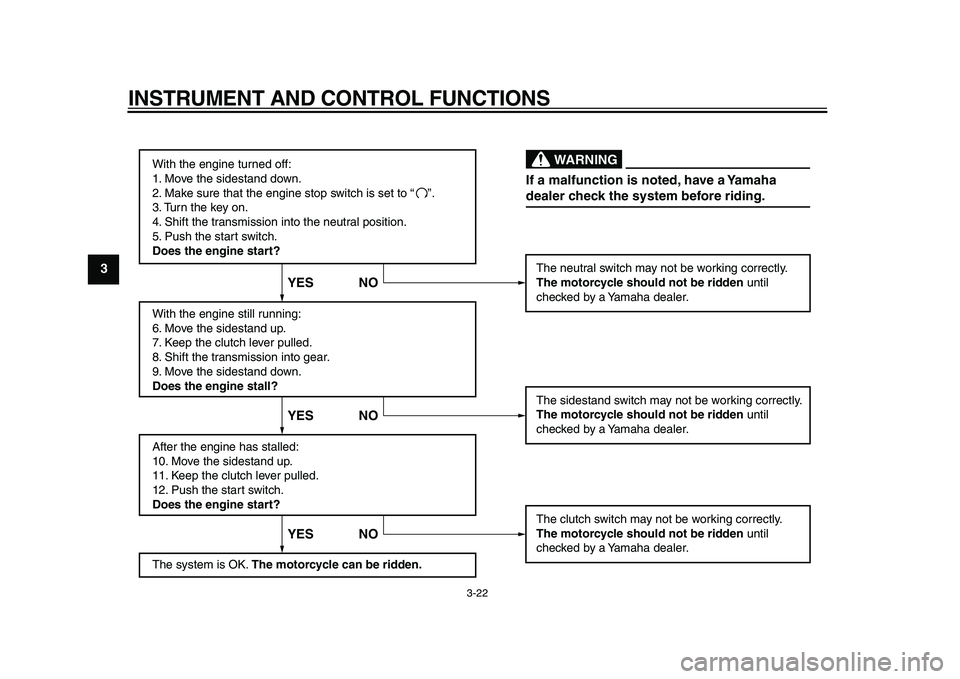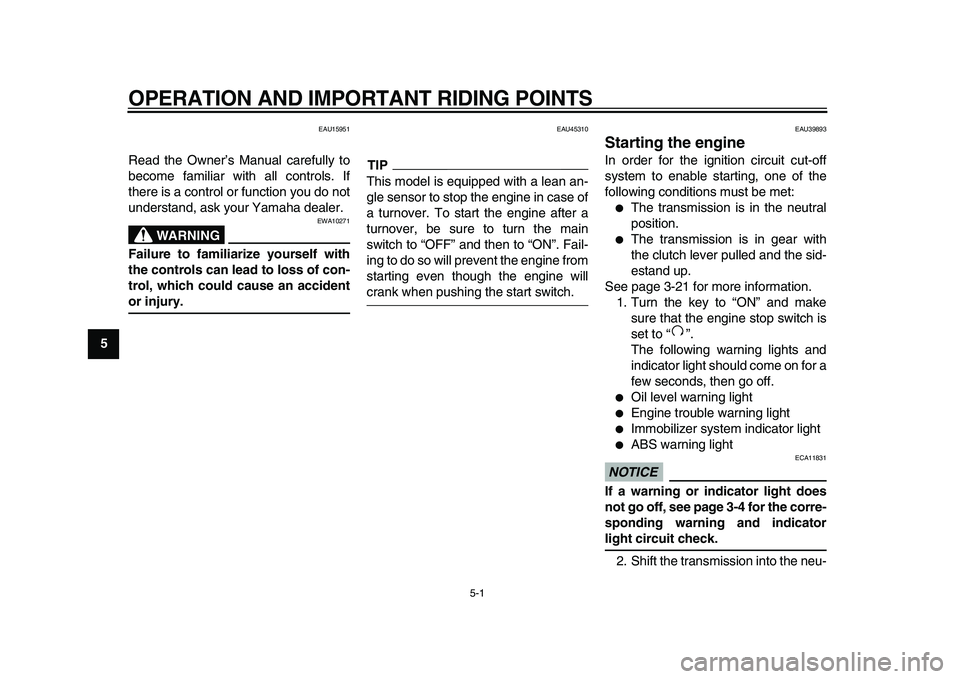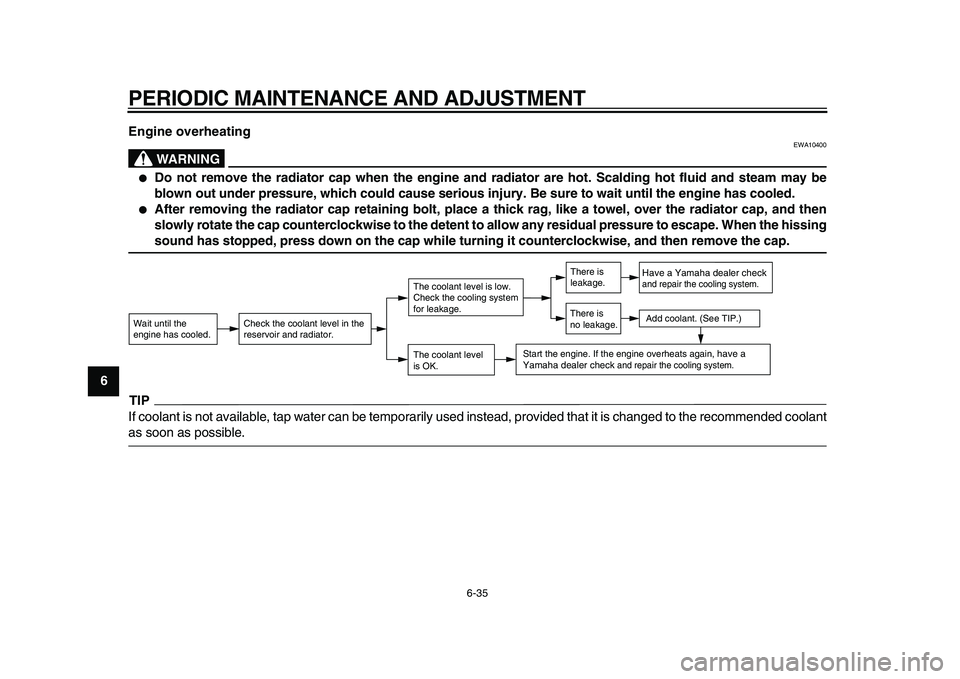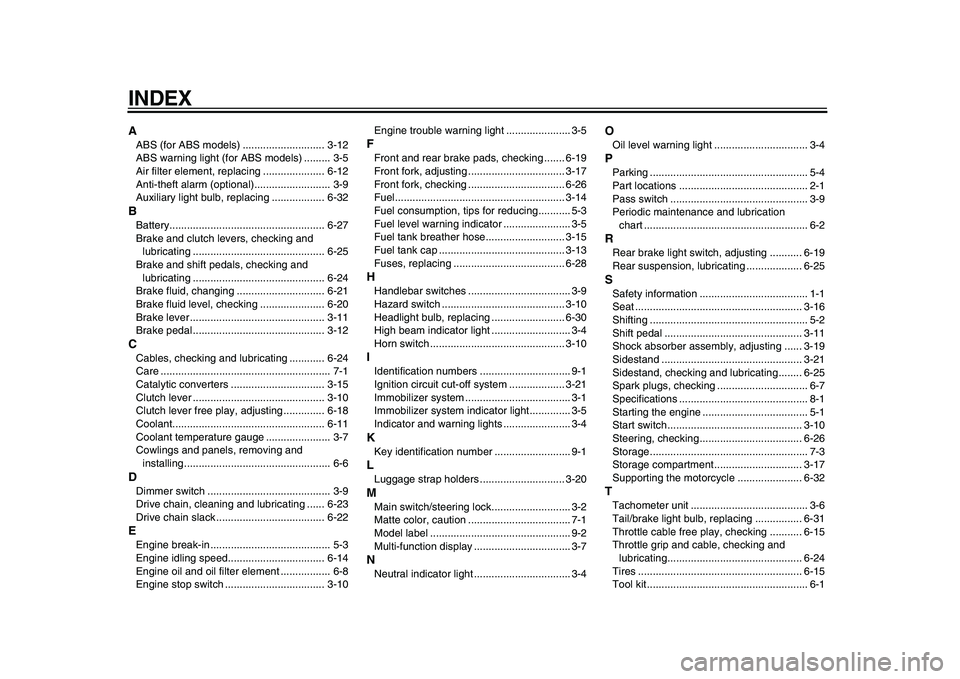stop start YAMAHA TDM 900 2009 Owners Manual
[x] Cancel search | Manufacturer: YAMAHA, Model Year: 2009, Model line: TDM 900, Model: YAMAHA TDM 900 2009Pages: 94, PDF Size: 3.75 MB
Page 21 of 94

INSTRUMENT AND CONTROL FUNCTIONS
3-5
2
34
5
6
7
8
9
warning light may flicker when riding on
a slope or during sudden acceleration
or deceleration, but this is not a mal-
function.
EAU11371
Fuel level warning indicator “ ”
This fuel level warning indicator starts
flashing when the fuel level drops be-
low approximately 3.5 L (0.92 US gal,
0.77 Imp.gal).
EAU11503
Engine trouble warning light “ ”
This warning light comes on or flashes
if a problem is detected in the electrical
circuit monitoring the engine. If this oc-
curs, have a Yamaha dealer check the
self-diagnosis system. (See page 3-7
for an explanation of the self-diagnosis
device.)
The electrical circuit of the warning light
can be checked by turning the key to
“ON”. If the warning light does not come
on for a few seconds, then go off, have
a Yamaha dealer check the electrical
circuit.
EAU11544
ABS warning light “ ” (for ABS
models)
If this warning light comes on or flashes
while riding, the ABS may not work cor-
rectly. If this occurs, have a Yamaha
dealer check the system as soon as
possible. (See page 3-12.)
WARNING
EWA10081
If the ABS warning light comes on or
flashes while riding, the brake sys-
tem reverts to conventional braking.
Therefore, be careful not to cause
the wheels to lock during emergen-
cy braking. If the warning light
comes on or flashes while riding,
have a Yamaha dealer check the
brake system as soon as possible.
The electrical circuit of the warning light
can be checked by turning the key to
“ON”.
If the warning light does not come on or
remains on, have a Yamaha dealer
check the electrical circuit.
EAU38611
Immobilizer system indicator light
The electrical circuit of the indicatorlight can be checked by turning the key
to “ON”.
If the indicator light does not come on
for a few seconds, then go off, have a
Yamaha dealer check the electrical cir-
cuit.
When the key is turned to “OFF” and 30
seconds have passed, the indicator
light will start flashing indicating the im-
mobilizer system is enabled. After 24
hours have passed, the indicator light
will stop flashing, however the immobi-
lizer system is still enabled.
TIP
This model is also equipped with a
self-diagnosis device for the immobiliz-
er system. If the immobilizer system is
not working correctly, the indicator light
will start flashing a pattern and the
odometer/tripmeter will display a 2-digit
code when the key is turned to “ON”.
When this occurs, have a Yamaha
dealer check the self-diagnosis system.
However, if the indicator light slowly
flashes five times, and then quickly
flashes two times repeatedly, error
code 52 will be displayed. This error
could be caused by signal interference.
ABS
Page 25 of 94

INSTRUMENT AND CONTROL FUNCTIONS
3-9
2
34
5
6
7
8
9
EAU12331
Anti-theft alarm (optional)
This model can be equipped with an
optional anti-theft alarm by a Yamaha
dealer. Contact a Yamaha dealer for
more information.
EAU12347
Handlebar switches
LeftRight
EAU12350
Pass switch “ ”
Press this switch to flash the headlight.
EAU12400
Dimmer switch “ / ”
Set this switch to “ ” for the high
beam and to “ ” for the low beam.
EAU12460
Turn signal switch “ / ”
To signal a right-hand turn, push this
switch to “ ”. To signal a left-hand
turn, push this switch to “ ”. When re-
leased, the switch returns to the center
1. Pass switch “ ”
2. Hazard switch “ ”
3. Dimmer switch “ / ”
4. Turn signal switch “ / ”
5. Horn switch “ ”
1
2
3
4
5
1. Engine stop switch “ / ”
2. Start switch “ ”
1
2
Page 26 of 94

INSTRUMENT AND CONTROL FUNCTIONS
3-10
1
2
3
4
5
6
7
8
9
position. To cancel the turn signal
lights, push the switch in after it has re-
turned to the center position.
EAU12500
Horn switch “ ”
Press this switch to sound the horn.
EAU12660
Engine stop switch “ / ”
Set this switch to “ ” before starting
the engine. Set this switch to “ ” to
stop the engine in case of an emergen-
cy, such as when the vehicle overturns
or when the throttle cable is stuck.
EAU12711
Start switch “ ”
Push this switch to crank the engine
with the starter. See page 5-1 for start-
ing instructions prior to starting the en-
gine.
EAU44710
The engine trouble warning light and
ABS warning light (ABS model only)
will come on when the key is turned to
“ON” and the start switch is pushed, butthis does not indicate a malfunction.
EAU12733
Hazard switch “ ”
With the key in the “ON” or “ ” posi-
tion, use this switch to turn on the haz-
ard lights (simultaneous flashing of all
turn signal lights).
The hazard lights are used in case of
an emergency or to warn other drivers
when your vehicle is stopped where it
might be a traffic hazard.
NOTICE
ECA10061
Do not use the hazard lights for an
extended length of time with the en-
gine not running, otherwise the bat-
tery may discharge.
EAU12820
Clutch lever
The clutch lever is located at the left
handlebar grip. To disengage the
clutch, pull the lever toward the handle-
bar grip. To engage the clutch, release
the lever. The lever should be pulled
rapidly and released slowly for smooth
clutch operation.
The clutch lever is equipped with a
clutch switch, which is part of the igni-
tion circuit cut-off system. (See
page 3-21.)
1. Clutch lever
1
Page 38 of 94

INSTRUMENT AND CONTROL FUNCTIONS
3-22
1
2
3
4
5
6
7
8
9
With the engine turned off:
1. Move the sidestand down.
2. Make sure that the engine stop switch is set to “
3. Turn the key on.
4. Shift the transmission into the neutral position.
5. Push the start switch.
Does the engine start?
With the engine still running:
6. Move the sidestand up.
7. Keep the clutch lever pulled.
8. Shift the transmission into gear.
9. Move the sidestand down.
Does the engine stall?
After the engine has stalled:
10. Move the sidestand up.
11. Keep the clutch lever pulled.
12. Push the start switch.
Does the engine start?
The system is OK. The motorcycle can be ridden.The neutral switch may not be working correctly.
The motorcycle should not be ridden until
checked by a Yamaha dealer.
The sidestand switch may not be working correctly.
The motorcycle should not be ridden until
checked by a Yamaha dealer.
The clutch switch may not be working correctly.
The motorcycle should not be ridden until
checked by a Yamaha dealer.
YES NO YES NO YES NO
If a malfunction is noted, have a Yamaha
dealer check the system before riding.
WARNING
”.
Page 42 of 94

5-1
1
2
3
4
5
6
7
8
9
OPERATION AND IMPORTANT RIDING POINTS
EAU15951
Read the Owner’s Manual carefully to
become familiar with all controls. If
there is a control or function you do not
understand, ask your Yamaha dealer.
WARNING
EWA10271
Failure to familiarize yourself with
the controls can lead to loss of con-
trol, which could cause an accident
or injury.
EAU45310
TIP
This model is equipped with a lean an-
gle sensor to stop the engine in case of
a turnover. To start the engine after a
turnover, be sure to turn the main
switch to “OFF” and then to “ON”. Fail-
ing to do so will prevent the engine from
starting even though the engine will
crank when pushing the start switch.
EAU39893
Starting the engine
In order for the ignition circuit cut-off
system to enable starting, one of the
following conditions must be met:
●
The transmission is in the neutral
position.
●
The transmission is in gear with
the clutch lever pulled and the sid-
estand up.
See page 3-21 for more information.
1. Turn the key to “ON” and make
sure that the engine stop switch is
set to “ ”.
The following warning lights and
indicator light should come on for a
few seconds, then go off.
●
Oil level warning light
●
Engine trouble warning light
●
Immobilizer system indicator light
●
ABS warning light
NOTICE
ECA11831
If a warning or indicator light does
not go off, see page 3-4 for the corre-
sponding warning and indicator
light circuit check.
2. Shift the transmission into the neu-
Page 80 of 94

PERIODIC MAINTENANCE AND ADJUSTMENT
6-35
1
2
3
4
5
6
7
8
9Engine overheating
WARNING
EWA10400
●
Do not remove the radiator cap when the engine and radiator are hot. Scalding hot fluid and steam may be
blown out under pressure, which could cause serious injury. Be sure to wait until the engine has cooled.
●
After removing the radiator cap retaining bolt, place a thick rag, like a towel, over the radiator cap, and then
slowly rotate the cap counterclockwise to the detent to allow any residual pressure to escape. When the hissing
sound has stopped, press down on the cap while turning it counterclockwise, and then remove the cap.
TIP
If coolant is not available, tap water can be temporarily used instead, provided that it is changed to the recommended coolant
as soon as possible.
Wait until the
engine has cooled.
Check the coolant level in the
reservoir and radiator.
The coolant level
is OK.The coolant level is low.
Check the cooling system
for leakage.
Have a Yamaha dealer checkand repair the cooling system.Add coolant. (See TIP.)
Start the engine. If the engine overheats again,
have a
Yamaha dealer check
and repair the cooling system.
There is
leakage.
There is
no leakage.
Page 90 of 94

INDEX
A
ABS (for ABS models) ............................ 3-12
ABS warning light (for ABS models) ......... 3-5
Air filter element, replacing ..................... 6-12
Anti-theft alarm (optional).......................... 3-9
Auxiliary light bulb, replacing .................. 6-32
B
Battery..................................................... 6-27
Brake and clutch levers, checking and
lubricating ............................................. 6-25
Brake and shift pedals, checking and
lubricating ............................................. 6-24
Brake fluid, changing .............................. 6-21
Brake fluid level, checking ...................... 6-20
Brake lever .............................................. 3-11
Brake pedal ............................................. 3-12
C
Cables, checking and lubricating ............ 6-24
Care .......................................................... 7-1
Catalytic converters ................................ 3-15
Clutch lever ............................................. 3-10
Clutch lever free play, adjusting .............. 6-18
Coolant.................................................... 6-11
Coolant temperature gauge ...................... 3-7
Cowlings and panels, removing and
installing.................................................. 6-6
D
Dimmer switch .......................................... 3-9
Drive chain, cleaning and lubricating ...... 6-23
Drive chain slack ..................................... 6-22
E
Engine break-in ......................................... 5-3
Engine idling speed................................. 6-14
Engine oil and oil filter element ................. 6-8
Engine stop switch .................................. 3-10Engine trouble warning light ...................... 3-5
F
Front and rear brake pads, checking ....... 6-19
Front fork, adjusting ................................. 3-17
Front fork, checking ................................. 6-26
Fuel.......................................................... 3-14
Fuel consumption, tips for reducing........... 5-3
Fuel level warning indicator ....................... 3-5
Fuel tank breather hose........................... 3-15
Fuel tank cap ........................................... 3-13
Fuses, replacing ...................................... 6-28
H
Handlebar switches ................................... 3-9
Hazard switch .......................................... 3-10
Headlight bulb, replacing ......................... 6-30
High beam indicator light ........................... 3-4
Horn switch .............................................. 3-10
I
Identification numbers ............................... 9-1
Ignition circuit cut-off system ................... 3-21
Immobilizer system .................................... 3-1
Immobilizer system indicator light.............. 3-5
Indicator and warning lights ....................... 3-4
K
Key identification number .......................... 9-1
L
Luggage strap holders ............................. 3-20
M
Main switch/steering lock........................... 3-2
Matte color, caution ................................... 7-1
Model label ................................................ 9-2
Multi-function display ................................. 3-7
N
Neutral indicator light ................................. 3-4
O
Oil level warning light ................................ 3-4
P
Parking ...................................................... 5-4
Part locations ............................................ 2-1
Pass switch ............................................... 3-9
Periodic maintenance and lubrication
chart ........................................................ 6-2
R
Rear brake light switch, adjusting ........... 6-19
Rear suspension, lubricating ................... 6-25
S
Safety information ..................................... 1-1
Seat ......................................................... 3-16
Shifting ...................................................... 5-2
Shift pedal ............................................... 3-11
Shock absorber assembly, adjusting ...... 3-19
Sidestand ................................................ 3-21
Sidestand, checking and lubricating........ 6-25
Spark plugs, checking ............................... 6-7
Specifications ............................................ 8-1
Starting the engine .................................... 5-1
Start switch .............................................. 3-10
Steering, checking................................... 6-26
Storage...................................................... 7-3
Storage compartment.............................. 3-17
Supporting the motorcycle ...................... 6-32
T
Tachometer unit ........................................ 3-6
Tail/brake light bulb, replacing ................ 6-31
Throttle cable free play, checking ........... 6-15
Throttle grip and cable, checking and
lubricating.............................................. 6-24
Tires ........................................................ 6-15
Tool kit....................................................... 6-1